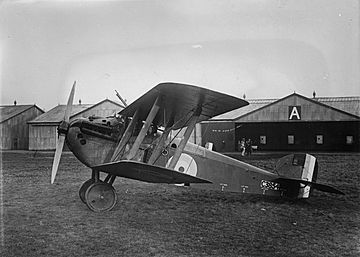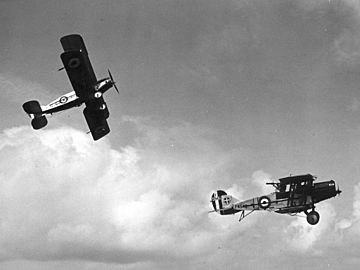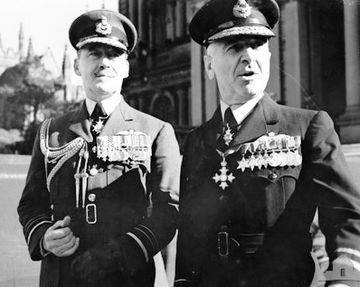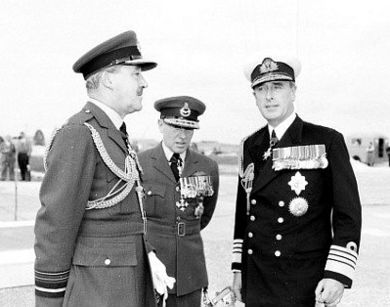Donald Hardman facts for kids
Quick facts for kids
James Donald Innes Hardman
|
|
|---|---|
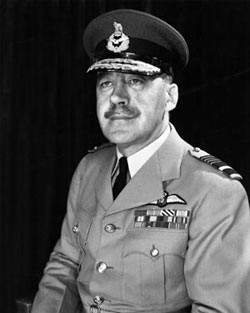
Air Marshal Donald Hardman as RAAF Chief of the Air Staff
|
|
| Born | 21 February 1899 Oldham, Lancashire, England |
| Died | 2 March 1982 (aged 83) Estoril, Portugal |
| Allegiance | United Kingdom |
| Service/ |
Royal Air Force |
| Years of service | 1916–58 |
| Rank | Air Chief Marshal |
| Unit | No. 19 Squadron (1918) No. 31 Squadron (1922–26) No. 16 Squadron (1926–28) No. 22 Group (1928–31, 1940) No. 216 Squadron (1931–34) No. 23 Group (1936–37) |
| Commands held | No. 232 Group (1945–46) RAF Staff College, Bracknell (1949–51) RAF Home Command (1951–52) Royal Australian Air Force (1952–54) |
| Battles/wars | World War I
World War II
|
| Awards | Knight Grand Cross of the Order of the British Empire Knight Commander of the Order of the Bath Distinguished Flying Cross Mentioned in Despatches Bronze Star (US) |
Sir James Donald Innes Hardman (born 21 February 1899 – died 2 March 1982), known as Donald Hardman, was a very important leader in the Royal Air Force (RAF). He started his flying career as a fighter pilot during World War I. He was so good that he shot down nine enemy planes, becoming a "flying ace."
During World War II, Hardman held important leadership roles. Later, he became the Chief of the Air Staff for the Royal Australian Air Force (RAAF) from 1952 to 1954. After that, he joined the British Air Council until he retired in 1958. He received several high awards for his service, including the Distinguished Flying Cross.
Contents
Early Life and World War I Heroics
Donald Hardman was born in Oldham, Lancashire, England, on 21 February 1899. His father was a cotton spinner. Donald went to Malvern College for his education.
In 1916, when he was just seventeen, Hardman joined the army as a private. Soon after, in 1917, he joined the Royal Flying Corps (RFC), which was the air force before the RAF. He became a temporary officer in May 1917.
At first, he was too young to fly in combat. But in February 1918, he joined No. 19 Squadron on the Western Front in France. His squadron flew Sopwith Dolphin planes. He got his first aerial victory in May 1918.
By September 1918, Hardman was promoted to temporary captain and became a flight commander. On 30 October 1918, he showed amazing skill. He led twelve Dolphin planes to protect bombers. In a big dogfight, where many planes were lost, Hardman shot down two German planes. His bravery and leadership earned him the Distinguished Flying Cross. By the end of the war, he had shot down nine enemy planes. Pilots on the Western Front had a very short life expectancy, so it was amazing that he survived.
Between the World Wars
After World War I, Hardman left the military for a short time. He studied economics at Hertford College, Oxford. But he soon returned to flying. In October 1921, he joined the Royal Air Force (RAF) as a flying officer.
He was sent to India in 1922, where he served with No. 31 Squadron. This unit worked closely with the army, flying Bristol Fighters during the Waziristan campaign. His position in the RAF became permanent in 1925.
Back in Britain, he joined No. 16 Squadron in 1926. He was promoted to flight lieutenant in 1927 and attended a special school for weapons and gunnery. He then worked at the headquarters of No. 22 (Army Co-operation) Group.
In 1930, Donald Hardman married Dorothy Ursula Ashcroft Thompson. They had two sons and a daughter. In 1931, he moved to Egypt to serve with No. 216 Squadron. This squadron flew Vickers Victoria planes for bombing and transport. They even helped create an air route from Lagos to Khartoum.
Hardman returned to Britain in 1935 to attend the RAF Staff College, Andover. He was promoted to squadron leader in 1936. For the next two years, he was a Staff Officer for Armament. In 1938, he attended another staff college, and by January 1939, he was promoted to wing commander.
World War II Contributions
When I first met Air Commodore Hardman, I immediately noticed his dignified manner, strong presence, and great sense of humor. We joked around a lot, and the atmosphere was very relaxed. But I also strongly felt that he meant business; it was clear there was a tough job ahead.
When World War II began, Hardman was sent to France with the RAF. After France fell in 1940, he worked at the headquarters of No. 22 Group. He also became a liaison officer with the British Army. Later, he took charge of a special department at the Air Ministry that dealt with military operations.
He was recognized for his "distinguished services" and was appointed an Officer of the Order of the British Empire in July 1940. He was also mentioned in official reports for his good work. In March 1941, he was promoted to temporary group captain.
In October 1944, Hardman became a temporary air commodore. He was sent to South East Asia to be the deputy commander of the Combat Cargo Task Force (CCTF). This force included RAF, Canadian, and US air units. Their job was to supply the Fourteenth Army during the Burma campaign.
In February 1945, Hardman became the Air Officer Commanding No. 232 (Transport) Group in India. He said that the Burma campaign showed how air power could supply ground troops without needing ground routes. This was a new way of fighting. For his excellent service in Burma, he was appointed a Companion of the Order of the Bath in July 1945. The US government also gave him the Bronze Star.
Important Post-War Roles
After the war, Hardman continued to rise in rank. He became an acting air vice-marshal in October 1945. He stayed in South-East Asia for a while, managing the administration for Air Command Far East.
When he returned to Britain, he held several important positions. He was Assistant Chief of the Air Staff, then Commandant of RAF Staff College, Bracknell, and finally Air Officer Commanding-in-Chief of Home Command. He was officially promoted to air commodore in 1946 and air vice-marshal in 1948. In October 1951, he became an acting air marshal.
On 14 January 1952, Hardman was chosen to be the Chief of the Air Staff (CAS) for the Royal Australian Air Force (RAAF). This was a big deal because he was an RAF officer, and some in Australia felt an Australian officer should have the job. However, Australia's Prime Minister, Robert Menzies, believed Hardman was the right person to reorganize the RAAF.
Hardman made two major changes to the RAAF. He combined RAAF Headquarters with the Department of Air. He also changed how the RAAF was organized, moving from geographical areas to three main functional commands: Home (for operations), Training, and Maintenance. This new system was a major lasting change he brought to the RAAF. He also worked with the Australian Navy to improve cooperation for sea warfare.
During his time as CAS, No. 78 (Fighter) Wing of the RAAF was given new jet fighters. They were sent to Malta to help with British operations there. In June 1952, Hardman was made a Knight Commander of the Order of the Bath. He was promoted to full air marshal in July.
Hardman strongly believed that an air force needed bombers to be truly powerful. He thought that to win, you had to attack the enemy's main centers, including where they made their fighter planes. He suggested the RAAF buy new, powerful "V bomber" planes, but this didn't happen.
Towards the end of his time in Australia, Hardman spoke about how important the Air Force was. He said it was the only force that could be sent anywhere in the world quickly. When he left Australia, people who had been worried about his appointment now praised him. The Age newspaper called him "the outstanding CAS in the RAAF's history" and a "brilliant organiser." John McCauley took over from him in January 1954.
Hardman returned to Britain and joined the British Air Council in May 1954. He became the Air Member for Supply and Organisation, responsible for getting supplies and organizing the RAF. In December, he attended a farewell parade for No. 78 Wing in Malta, the same unit he had seen off from Australia.
He was promoted to air chief marshal on 1 April 1955. In July 1956, he presented a special flag to his old unit, No. 19 Squadron. He also led an investigation into a plane crash at Heathrow Airport in October 1956. Hardman retired from the RAF on 29 January 1958, and on the same day, he was given the very high honor of Knight Grand Cross of the Order of the British Empire.
Later Life
After retiring from the RAF, Sir Donald Hardman joined the board of a company called New Electronic Products Ltd in May 1959. In February 1963, he became an honorary representative for the RAF Benevolent Fund in Hampshire, helping former RAF members.
Sir Donald Hardman passed away on 2 March 1982, while on holiday in Estoril, Portugal. He was survived by his wife and children.


